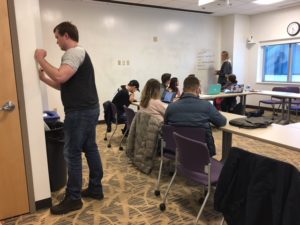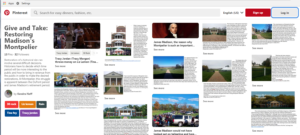In my Intro to Public History class, I usually require some sort of digital assignment as one of three short projects. The first project uses historic Sanborn fire insurance maps and requires each student to walk a different city block and submit an essay analyzing changes in the cultural landscape from past to present. The second project has been the creation of a personal website, inspired by a Domain of One’s Own, where the students can create a portfolio of their work in various classes, including mine. The third project always relates to James Madison’s historic home, Montpelier, which I use as a case study to explore multiple branches of public history at one historic property. This semester, I changed the second project to Adobe Spark glideshows documenting a local Confederate monument and the third shifted to a digital commonplace book focused thematically on Montpelier.
The idea came from a tweet by historian Joe Adelman, who has had students create analog versions in his colonial history classes. Commonplace books are well known to historians of early America. Literate people used blank journals to curate quotes or passages from books that they wanted to remember and contemplate. After copying the words onto a page, they typically provided a short annotation that captured what they found compelling about the quote in the first place. (Here is a link to James Madison’s very own commonplace book.) As I explained in the assignment prompt, “commonplace books served as tools for learning, self-improvement, remembrance, and reflection.”
Adelman’s tweet led to his blog post describing his approach, but it also included links to other professors’ version of the assignment, like this one by Vimala Pasupathi. A casual search revealed that commonplacing is also very popular outside the classroom. Thanks to Tumblr, Pinterest, OneNote and WordPress, it is fairly easy to adapt the practice. I found all sorts of commonplace books online, and they are produced by all sorts of people: grad students keeping track of academic work, artists and writers recording their inspiration, book reviewers, bloggers and scholars doing research, and so forth. In each case, what caught my attention was the way the creators consciously called their websites “commonplace books” and the way their posts used a quote from a written text to spark a personal reflection. There were quite a few posts, however, that sprang from an image, such as a digital photo of the book or passage in question, or a meme the author had created to showcase the quote or image. I thought that that kind of creativity opened up interesting possibilities for undergraduates, who are not very ‘bookish’.

My students doing an in-class exercise involving a Montpelier furnishing plan. The plan was one of multiple readings they could quote for their digital commonplace books.
My class draws a mixture of majors. About half are from History and most of these are pursuing the public history concentration. Other students come from our k-8 teacher preparation program, from art and art history (where we have a museum studies concentration), and anthropology (archaeology concentration). There are always one or two other people who are just looking for an interesting elective. The goal of the assignment was to give them a personalized way “to demonstrate through your choice of texts and annotations that you have been reading and thinking deeply about public history.” Although everyone was expected to do close reading of assigned course materials and to attend the field trip to Montpelier, they had free reign to choose quotes, passages, or visuals that seemed noteworthy or intriguing or compelling to them as individuals with specific interests. I stipulated a minimum word count of 1400 words across their annotations (that is roughly equal to what they supplied in their Sanborn essays.) The students were also required to give short, in-class presentations showcasing their digital commonplace books and communicating the “big takeaway” or meaning each made of Montpelier as a result of this project.
Thus, I imagined them, over the final third of the semester, jotting down intriguing quotes in their notes—the sort of thing that typically gets underlined or highlighted-then capturing their thoughts about that quote, how it conveyed a key point of the essay or a public history concept they found interesting or puzzling (like “virtual tourism”). I allowed them to pick whatever platform they felt comfortable with, such as Tumblr, Pinterest, Instagram, or WordPress, and I encouraged them to be creative visually, as appropriate. Why not use Canva to add words to an image of an object from a furnishing plan? Why not take a selfie at Montpelier and then examine what a tourist hears on the standard tour? In the assignment prompt and verbally in class, I explained that it was not a linear project; it was not to be an essay chunked up into multiple posts; it could not be done at the last minute; it was more like a journal, albeit one grounded in course materials and organized around a place. It turned out to be a tall order for some of them.
Unfortunately, snow required me to cancel an in-class workshop and to integrate a shorter presentation and activity during which they reviewed various examples of digital commonplace books. I encouraged them to come to office hours for help and to seek support from our campus’s Digital Communication Center. Some students asked me for further guidance at a conceptual level, and only a few asked me to review preliminary posts and give feedback. I was worried when four or five people stayed after class the week before final presentations (late April) to say they hadn’t even started yet. Had they not been journaling/taking notes on the previous four weeks of readings and class discussions? Apparently, these students had not.
It turned out that the biggest challenge this assignment presented was not the digital component. All semester, in fact, a big chunk of the class had struggled to manage the assigned readings. In keeping with departmental guidelines for 300-level History courses, each class period rested on the equivalent of two scholarly journal essays; sometimes the readings were a chapter of the common text, Thomas Cauvin’s Public History, and an article; sometimes I paired the assigned chapter or article for the day with a meaty public history product like a podcast, a furnishing plan, or a set of posts on a professional website. While I don’t doubt that the students were reading, most of them seemed to be reading passively and selectively, skimming to get the general jist of things, especially as Spring arrived and the end of the semester neared. That isn’t new. For years now, I have bemoaned the wide range of literacy skills possessed by undergraduates; even History majors often lack the ability to identify arguments, take effective notes, and synthesize ideas and information from multiple sources. A commonplace book, by definition, is a tool for improving literacy and erudition. The ones who did really well on this assignment, then, were those who did well overall, who usually (though not every day) read carefully and deeply, conveyed their engagement with the readings verbally and on quizzes, and who took responsibility for their own learning rather than supplying what they thought I wanted.
Overall, I think the digital commonplace book is a good idea and worth trying again. Multiple students conveyed in their posts/annotations a sophisticated grasp of public history, such as the one who clearly connected readings on the field’s shift toward social activism to Montpelier’s “The Mere Distinction of Colour” closing video with its overt visual ties to #BlackLivesMatter.(https://taintedbyliberty.tumblr.com/) Some also used the project to dive more deeply into an especially appealing aspect of public history.
Here are two additional projects:
https://montpelierenslavedcommunity.tumblr.com/
https://www.instagram.com/teaching_publichistory/
Now that I have multiple good examples, it will be easier for everyone to understand the end goal. Despite a detailed, two-page prompt, a lot of in-class explanation, and a rubric, some students simply couldn’t imagine a product that fell outside the “write an essay” paradigm. In fact, several produced sites with posts that read more like a single, coherent narrative. Some unfortunately used their project primarily to offer reactions to or recollections of the Montpelier field trip, rather than engaging course materials, while some made egregious errors that revealed their fundamental misunderstanding of a concept, interpretive strategy, or author. These problems occur with any assignment, of course, and I am still reflecting on how to help students avoid them. Would Hypothes.is help model close reading, for example? Or should I assign analog commonplacing for a few days to provide early feedback? I think both sound appropriate.
Thanks for reading. In a future post, I’ll describe the Confederate monument glideshow project mentioned above. It is based on a glideshow created by Jim Leloudis to explain the history of UNC-Chapel Hill’s Silent Sam monument. Like the digital commonplace book, it required students to go beyond the essay (which is what my students do for the Sanborn map-cultural landscape project) and produce something more “public.”

